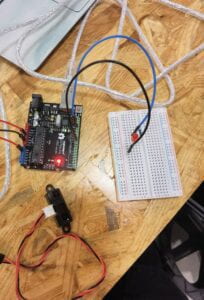INTERACTION LAB RECITATION 3
Recitation 3: Sensors
We chose the Infrared Distance Sensor. With the example code, we successfully obtained the sensor readings. The “map()” function can help to map the analog readings from the sensor to the distance between the sensor and the object, but we didn’t use it.
In the process of observing the readings, we found that the abnormal figure of “400cm” sometimes appeared. The professor told us that this is because the detection range of the infrared distance sensor is 4-30cm.
After that, we added the code for the LED to light up when the object is detected to be close. We also tried to make the light brighter the closer the object was.
Our codes and circuits:


(The code is on my partner’s computer. I’ll rewrite it sometime later and embed it into the blog.)
Question 1:
What did you intend to assemble in the recitation exercise? If your sensor/actuator combination were to be used for pragmatic purposes, who would use it, why would they use it, and how could it be used?
In the recitation exercise, we assembled infrared distance sensor and LED. For pragmatic purposes, I think it can be used in some traffic safety scenarios, such as reversing. But the detection range of the infrared distance sensor is small, maybe ultrasonic ranger is more suitable. In addition, if the LED is replaced with a buzzer, it can be used to make a blind cane for blind people or people with visual impairment to remind them of the distance of obstacles.
Question 2:
Code is often compared to following a recipe or tutorial. Why do you think that is?
If I understand this sentence correctly, it is saying that we are always writing programs whose code tends to follow the tutorial and nothing has changed. Code is the medium between computer language and human language. So the code must be ordered and formatted so that the computer understands the human instructions. On a simple example, we can only follow the logic of the language and cannot change its basic rules at will. But it is the creators who need to think about how to use these rules and the digital language for “programming creation”. After we learn the “recipes and tutorials”, the next step is to learn to use them flexibly to create more complex projects.
Question 3:
In The Language of New Media, Manovich describes the influence of computers on new media. In what ways do you believe the computer influences our human behaviors?
From Manovich’s perspective, the computer makes the media mathematically representable and programmable. I think computer algorithms are somehow digitizing complex human behavior. Video sites and shopping sites, for example, calculate user preferences for ad push. In the take-out industry, the estimated delivery time is also calculated by a computer through some kind of algorithm. In the era of big data, it is a thought-provoking question whether people are always influenced by computer data and whether they can still have their own preferences and thinking.